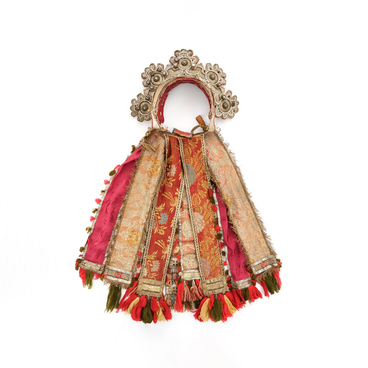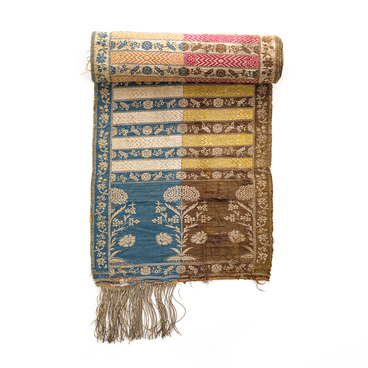A carved board called a woodblock, or “manera” in Russian, was used for printing on textiles. Woodblocks were made from a single piece of solid wood, like birch, maple, or pear. The boards had a square or rectangular shape, and some were wedge-shaped. The blocks were small, usually 20 by 20 centimeters, with a thickness of 3 to 5 centimeters. A pattern was cut out on a woodblock in low relief. Then, the woodblock was dipped in paint or vapa (a coloring agent) and placed on a cloth spread out on a table. Finally, the block was tapped with a wooden hammer and the pattern was thus printed on the cloth.
Originally, an image was printed on the fabric, using red or orange dyes on a white or painted background. In order to print a design on a large piece of fabric, a block was applied multiple times along the entire length and width of the fabric according to special markings. Thus, a basic element was repeated on the fabric several times. It is known as the rapport pattern. If it was necessary to apply a multicolored pattern to the fabric, then several blocks were used. The number of colors corresponded to the number of boards applied sequentially to the fabric.
The first Russian prints on textiles were mostly fine patterns, based on floral motifs that were largely abstract. In time, carvers honed their skills and created exquisite woodblocks. As the technology of carving and printing developed, the designs became more sophisticated. In the 19th century, carved blocks were supplemented with inserts of metal strips curved in accordance with the pattern, as well as metal studs with and without caps. Metal strips and nails framed the vibrant colorful pattern with a thin contour, complemented with small “peas”. These inserts were needed to fill in the background.
Carvers and printmakers were not afraid of shifting the color accents of the ornament in relation to the contour: they often purposefully constructed the pattern so that in some places the contour line was placed over the edges of the image, and in others — it moved away from them. The same principle was applied to the printed background — smooth or patterned: the pattern was built in such a way that the natural color of the fabric could be seen around the ornate shapes and bouquets. This gap was narrow in some places, and larger in others. These simple techniques enriched the printed design and ensured that the final image did not look too precise and rigid.
The woodblock presented in the Museum of Russian
Heritage is made of a single piece of wood and decorated with double-sided
carvings. One side features an image of flowerpots in ovals connected by
rosettes, framed by stylized wreaths and flowers. The other side depicts small
flowers in rhombuses.


